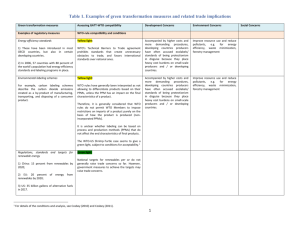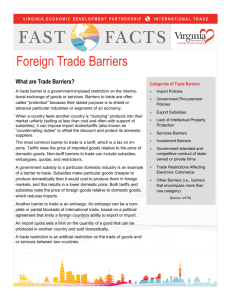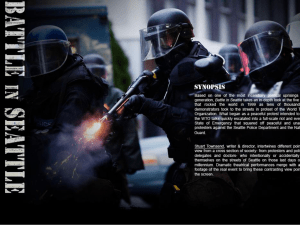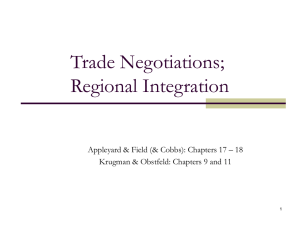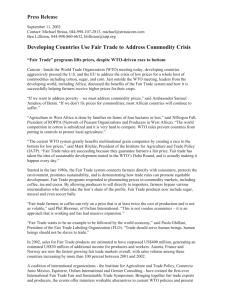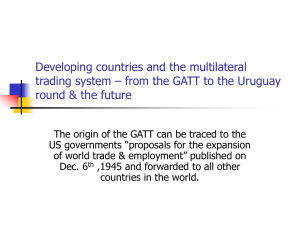The Political Economy of International Trade
advertisement
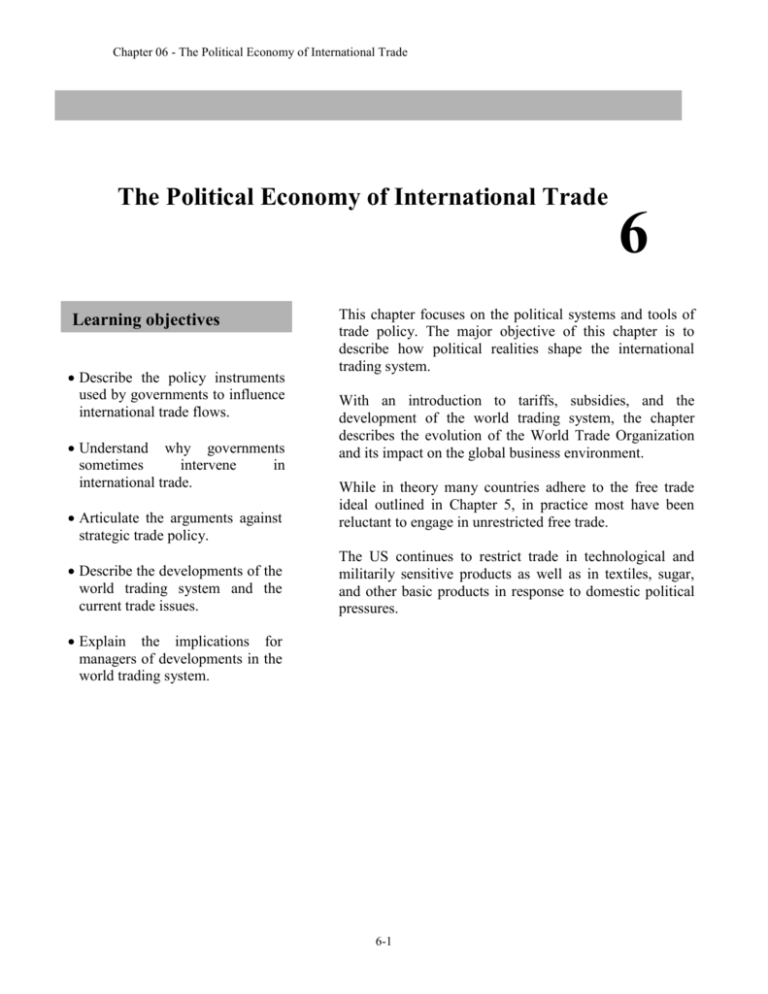
Chapter 06 - The Political Economy of International Trade
The Political Economy of International Trade
6
Learning objectives
Describe the policy instruments
used by governments to influence
international trade flows.
Understand why governments
sometimes
intervene
in
international trade.
Articulate the arguments against
strategic trade policy.
Describe the developments of the
world trading system and the
current trade issues.
This chapter focuses on the political systems and tools of
trade policy. The major objective of this chapter is to
describe how political realities shape the international
trading system.
With an introduction to tariffs, subsidies, and the
development of the world trading system, the chapter
describes the evolution of the World Trade Organization
and its impact on the global business environment.
While in theory many countries adhere to the free trade
ideal outlined in Chapter 5, in practice most have been
reluctant to engage in unrestricted free trade.
The US continues to restrict trade in technological and
militarily sensitive products as well as in textiles, sugar,
and other basic products in response to domestic political
pressures.
Explain the implications for
managers of developments in the
world trading system.
6-1
Chapter 06 - The Political Economy of International Trade
OUTLINE OF CHAPTER 6: THE POLITICAL ECONOMY OF INTERNATIONAL
TRADE
Opening Case: United States Cotton Subsidies and World Trade
Introduction
Instruments of Trade Policy
Tariffs
Subsidies
Import Quotas and Voluntary Export Restraints
Local Content Requirements
Administrative Policies
Antidumping Policies
Country Focus: Subsidized Wheat Production in Japan
Management Focus: U.S. Magnesium Seeks Protection
The Case for Government Intervention
Political Arguments for Intervention
Economic Arguments for Intervention
Country Focus: Trade in Hormone-Treated Beef
The Revised Case for Free Trade
Retaliation and Trade War
Domestic Politics
Development of the World Trading System
From Smith to the Great Depression
1947–1979: GATT, Trade Liberalization, and Economic Growth/
1980–1993: Protectionist Trend
The Uruguay Round and the World Trade Organization
WTO: Experience to Date
The Future of the WTO: Unresolved Issues and the Doha Round
Country Focus: Estimating the Gains from Trade for America
Implications for Managers
Trade Barriers and Firm Strategy
Policy Implications
6-2
Chapter 06 - The Political Economy of International Trade
Chapter Summary
Critical Thinking and Discussion Questions
Closing Case: Trade in Textiles—Holding the Chinese Juggernaut in Check
CLASSROOM DISCUSSION POINT
Ask students whether the United States promotes free trade. Jot their responses on the
board.
Then try to dig a little deeper by asking why, if the United States promotes free trade, it
still maintains some trade barriers (have some current trade barriers in mind such as the
$3.4 billion in subsidies U.S. cotton farmers received in 2001). Write the responses of
students on the board using the basic arguments for intervention framework presented in
the text.
Next, ask students similar questions about the European Union (EU dairy farms receive $
15 billion a year in subsidies).
OPENING CASE: United States Cotton Subsidies and World Trade
The opening case examines the issue of subsidies paid by the United States government
to American cotton farmers. The subsidies have been in place since the depression, and
in 2005, amounted to $5 billion. Given that the cotton crop was worth just $4 billion, it is
clear that the farmers could not survive without the subsidies, but other countries have
complained that the subsidies violate the World Trade Agreement. Discussion of the case
can revolve around the following questions:
1. Why does the United States continue to pay subsidies to its cotton farmers? Are the
subsidies fair? Why or why not? Do you think they violate World Trade Organization
agreements?
2. What would happen to cotton farmers in the United States if they were not subsidized?
Where would cotton production take place?
3. Should the United States continue to subsidize cotton farmers? Can the subsidies be
legitimized under a national security argument?
Another Perspective: To see where the WTO is on its investigation of the cotton
subsidies, go to the WTO website {http://www.wto.org/} and click on trade topics, then
on agriculture.
6-3
Chapter 06 - The Political Economy of International Trade
LECTURE OUTLINE
This lecture outline follows the Power Point Presentation (PPT) provided along with this
instructor’s manual. The PPT slides include additional notes that can be viewed by
clicking on “view”, then on “notes”. The following provides a brief overview of each
Power Point slide along with teaching tips, and additional perspectives.
Slides 6-3 Introduction
Free trade refers to a situation where a government does not attempt to restrict what its
citizens can buy from another country or what they can sell to another country.
Slide 6-4 Instruments of Trade Policy
The main instruments of trade policy are:
tariffs
subsidies
import quotas
voluntary export restraints
local content requirements
antidumping policies
administrative policies
Slide 6-5 Tariffs
Tariffs are the oldest form of trade policy. The principal objective of most tariffs is to
protect domestic producers and employees against foreign competition. Tariffs also raise
revenue for the government. Domestic producers gain, because tariffs afford them some
protection against foreign competitors by increasing the cost of imported foreign goods.
Consumers lose because they must pay more for certain imports. Tariffs reduce the
overall efficiency of the world economy.
Slide 6-6 Subsidies
Subsidies take many forms (cash grants, low-interest loans, tax breaks, and government
equity participation in domestic firms). By lowering production costs, subsidies help
domestic producers in two ways: they help them compete against foreign imports and
they help them gain export markets. Subsidy revenues are generated from taxes.
Governments typically pay for subsidies by taxing individuals. Therefore, whether
subsidies generate national benefits that exceed their national costs is debatable.
Subsidies encourage over production, inefficiency and reduced trade. In practice, many
subsidies are not that successful at increasing the international competitiveness of
domestic producers. Rather, they tend to protect the inefficient and promote excess
production.
6-4
Chapter 06 - The Political Economy of International Trade
Slide 6-8 Quotas and Voluntary Export Restraints
Quotas and Voluntary Export Restraints (VER) are direct restrictions on the quantity
of some good that may be imported into a country. The quota restriction is usually
enforced by issuing import licenses to a group of individuals or firms. A VER is a quota
on trade imposed by the exporting country, typically at the request of the importing
country’s government.
Slide 6-9 Local Content Requirements
Local content regulations have been widely used by developing countries to shift their
manufacturing base from the simple assembly of products whose parts are manufactured
elsewhere into the local manufacture of component parts. They have also been used in
developed countries to try to protect local jobs and industry from foreign competition.
From the point of view of a domestic producer of parts going into a final product, local
content regulations provide protection in the same way an import quota does: by limiting
foreign competition. The aggregate economic effects are also the same; domestic
producers benefit, but the restrictions on imports raise the prices of imported components.
Slide 6-11 Administrative Policies
Governments sometimes use informal or administrative policies to restrict imports and
boost exports. Administrative trade policies are bureaucratic rules that are designed to
make it difficult for imports to enter a country.
Another Perspective: Information about U.S. trade is readily available on government
sites. Visit {www.business.gov} to access an array of links. You can also review the
current U.S. tariffs at the U.S. Office of Tariff Affairs and Trade Agreements,
{www.usitc.gov/tata/index.htm}.
Slide 6-12 Anti Dumping Policies
Dumping is defined as selling goods in a foreign market at below cost of production or at
below “fair” market value.
Slide 6-13 The Case for Government Intervention
There are two types of arguments for government intervention, political and economic.
Slides 6-14 Political Arguments for Intervention
Political arguments for government intervention include:
protecting jobs
protecting industries deemed important for national security
retaliating to unfair foreign competition
protecting consumers from “dangerous” products
furthering the goals of foreign policy
protecting the human rights of individuals in exporting countries
6-5
Chapter 06 - The Political Economy of International Trade
Slide 6-16 Protecting Jobs and Industries
The most common political reason for trade restrictions is "protecting jobs and
industries."
Slide 6-17 Protecting National Security
Countries sometimes argue that it is necessary to protect certain industries because they
are important for national security. Defense-related industries often get this kind of
attention (e.g., aerospace, advanced electronics, semiconductors).
Slide 6-18 Retaliation
Government intervention in trade can be used as part of a "get tough" policy to open
foreign markets.
Slide 6-19 Protecting Consumers
Consumer protection can also be an argument for restricting imports. Since different countries do
have different health and safety standards, what may be acceptable in one country may be
unacceptable in others.
Slide 6-20 Furthering Policy Objectives
Sometimes, governments use trade policy to support their foreign policy objectives.
Slide 6-21 Protecting Human Rights
Governments sometimes use trade policy to create pressure for improvement of human
rights policies of trading partners. For years the most obvious example of this was the
annual debate in the United States over whether to grant most favored nation (MFN)
status to China. MFN status allows countries to export goods to the United Status under
favorable terms. Under MFN rules, the average tariff on Chinese goods imported into the
United States is 8 percent. If China’s MFN status were rescinded, tariffs would probably
rise to about 40 percent.
Another Perspective: In the United States, the Bureau of Export Administration enhances
the nation's security and its economic prosperity by controlling exports for national
security, foreign security, foreign policy, and short supply reasons. The Bureau of Export
Administration maintains a web site at
{http://www.technology.gov/Reports/Compendium/doc.pdf}.
Slide 6-22 Economic Arguments for Intervention
Protecting infant industries and strategic trade policy are the main economic reasons for
trade restrictions.
6-6
Chapter 06 - The Political Economy of International Trade
Slide 6-24 The Infant Industry Argument
The infant industry argument has been considered a legitimate reason for
protectionism, especially in developing country contexts. Many economists criticize this
argument: protection of manufacturing from foreign competition does no good unless the
protection helps make the industry efficient. Brazil built up the world’s 10th largest auto
industry behind tariff barriers and quotas. Once those barriers were removed in the late
1980s, however, foreign imports soared and the industry was forced to face up to the fact
that after 30 years of protection, the Brazilian industry was one of the most inefficient in
the world.
Slide 6-25 Strategic Trade Policy
Strategic trade policy, where the existence of substantial scale economies suggests that
the world market will profitably support only a few firms, and may justify government
intervention in industries with possibly large economies of scale. Such intervention
reduces the competitive effect of existing first-mover advantage held by a foreign
company.
Slide 6-26 Revised Case for Free Trade
While strategic trade policy identifies conditions where restrictions on trade may provide
economic benefits, there are two problems that may make restrictions inappropriate:
retaliation and politics.
Slide 6-27 Retaliation and Trade War
Krugman argues that strategic trade policies aimed at establishing domestic firms in a
dominant position in a global industry are beggar-thy-neighbor policies that boost
national income at the expense of other countries.
Slide 6-28 Domestic Policies
Special interest groups may influence governments.
Slide 6-30 Development of the World Trading System
How has today’s world trade system evolved?
Slide 6-31 From Smith to the Great Depression
Up until the Great Depression of the 1930s, most countries had some degree of
protectionism. Great Britain, as a major trading nation, was one of the strongest
supporters of free trade.
Although the world was already in a depression, in 1930 the U.S. enacted the SmootHawley tariff, which created significant import tariffs on foreign goods. As other nations
took similar steps and the depression deepened, world trade fell further.
6-7
Chapter 06 - The Political Economy of International Trade
Slide 6-32 1947-79: GATT, Trade Liberalization, and Economic Growth
After WWII, the U.S. and other nations realized the value of freer trade, and established
the General Agreement on Tariffs and Trade (GATT).
The approach of GATT (a multilateral agreement to liberalize trade) was to gradually
eliminate barriers to trade. Over 100 countries became members of GATT, and worked
together to further liberalize trade.
Teaching Tip: A full review of GATT, containing an actual copy of the agreement, is
available at {http://www.ciesin.org/TG/PI/TRADE/gatt.html}.
Slide 6-33 1980-1993: Protectionist Trends
Calls for protectionism were motivated by 3 factors:
1. Japan’s success in such industries as automobiles and semiconductors coupled with the
sense that Japanese markets were closed to imports and foreign investment by
administrative trade barriers.
2. The world’s largest economy, the United States, was plagued by a persistent deficit.
The loss of market share to foreign competitors in industries such as automobiles,
machine tools, semiconductors, steel, and textiles, and the resulting unemployment gave
rise to renewed demands in the U.S. Congress for protection against imports.
3. Many countries found ways to get around GATT regulations.
Slide 6-34 The Uruguay Round and the World Trade Organization
The Uruguay Round wrote the rules governing:
-the protection of intellectual property rights
-the reduction of agricultural subsidies
-the strengthening of GATT’s monitoring and enforcement mechanisms
Slide 6-35 – 6-37 The WTO: Experience to Date
In addition to the impasse at the meetings over agricultural subsidies, the Seattle round
was a lightning rod for a diverse collection of organizations from environmentalists and
human rights groups to labor unions that opposed free trade. All these organizations
argued that the WTO is an undemocratic institution that was usurping the national
sovereignty of member states and making decisions of great importance behind closed
doors. They took advantage of the Seattle meetings to voice their opposition.
6-8
Chapter 06 - The Political Economy of International Trade
Slides 6-38- 6-40 The Future of the WTO: Unresolved Issues and the Doha Round
The Doha Round had several initiatives:
Cutting tariffs on industrial goods and services. In 2000, for example, the average tariff
rates on non-agricultural products were 4.4% for Canada, 4.5% for the European Union,
4.0% for Japan, and 4.7% for the United States. On agricultural products, however, the
average tariffs rates were 22.9% for Canada, 17.3% for the European Union, 18.2% for
Japan, and 11% for the United States.
Phasing out subsidies. Subsidies introduce significant distortions into the production of
agricultural products. The net effect is to raise prices to consumers, reduce the volume of
agricultural trade, and encourage the overproduction of products that are heavily
subsidized (with the government typically buying up the surplus).
Reducing antidumping laws. WTO rules allow countries to impose antidumping duties
on foreign goods that are being sold cheaper than at home, or below their cost of
production, when domestic producers can show that they are being harmed.
WTO on intellectual property should allow for health protection in poorer nations. Rich
countries have to comply with the rules within a year. Poor countries, in which such
protection generally was much weaker, have 5 years’ grace, and the very poorest have 10
years.
Another Perspective: To see current issues at the WTO, go to {http://www.wto.org} and
click on “News.”
Slide 6-42 Implications for Managers
Managers need to consider how trade barriers affect the strategy of the firm and the
implications of government policy on the firm.
Slide 6-43 Trade Barriers and Firm Strategy
Trade barriers are a constraint upon a firm’s ability to disperse its productive activities.
Slide 6-44 Policy Implications
International firms have an incentive to lobby for free trade, and keep protectionist
pressures from causing them to have to change strategy.
6-9
Chapter 06 - The Political Economy of International Trade
CRITICAL THINKING AND DISCUSSION QUESTIONS
QUESTION 1: Do you think that governments should consider human rights when
granting preferential trading rights to countries? What are the arguments for and against
taking such a position?
ANSWER 1: China is frequently cited as a violator of human rights, and can form the
basis for a discussion of this question. While the answer to the first question clearly is a
matter of personal opinion, in stating their opinions, students should consider the
following points. Trade with the U.S. is very important to China, as China views the U.S.
as an important market. The U.S. is also an important source of certain products. Thus,
the U.S. has some leverage with trade when trying to influence China’s human rights
policies. For this policy to have much effect, however, other nations important to China
must adopt similar policies. Otherwise China will simply choose to work with other
countries, and U.S. consumers and producers may be more negatively impact than the
Chinese. Another concern with tying MFN status to human rights is that denying MFN
may make the human rights situation worse rather than better. By engaging in trade, the
income levels in China will increase, and with greater wealth the people will be able to
demand and receive better treatment.
QUESTION 2: Whose interests should be the paramount concern of government trade
policy - the interests of producers (businesses and their employees) or those of
consumers?
ANSWER 2: The long run interests of consumers should be the primary concern of
governments, based on a utilitarian approach (the most good). Unfortunately consumers,
each of whom may be negatively impacted by only a few dollars, are less motivated and
effective lobbyists than are a few producers who may have a great deal at stake. While in
some instances it may be argued that domestic consumers will be better off if world-class
domestic producers are nurtured and allowed to gain first mover advantages in
international markets, it is doubtful that the government will be better than international
capital markets at "picking winners", and will more likely pick the firms with the greatest
political clout. While employees may well lose jobs if there are more efficient foreign
competitors, some would argue that this is the nature of competition, and that the role of
government should be to help these employees get jobs where they can be efficiently
employed rather than to protect them from reality in inefficient firms.
QUESTION 3: Given the arguments relating to the new trade theory and strategic trade
policy, what kind of trade policy should business be pressuring government to adopt?
6-10
Chapter 06 - The Political Economy of International Trade
ANSWER 3: According to the textbook, businesses should urge governments to target
technologies that may be important in the future and use subsidies to support
development work aimed at commercializing those technologies. Government should
provide export subsidies until the domestic firms have established first mover advantages
in the world market. Government support may also be justified if it can help domestic
firms overcome the first-mover advantages enjoyed by foreign competitors and emerge as
viable competitors in the world market. In this case, a combination of home market
protection and export-promoting subsidies may be called for.
QUESTION 4: You are an employee of an U.S. firm that produces personal computers
in Thailand and then exports them to the U.S. and other countries for sale. The personal
computers were originally produced in Thailand to take advantage of relatively low labor
costs and a skilled workforce. Other possible locations considered at that time were
Malaysia and Hong Kong. The US government decides to impose punitive 100% ad
valorem tariffs on imports of computers from Thailand to punish the country for
administrative trade barriers that restrict U.S. exports to Thailand. How do you think
your firm should respond? What does this tell you about the use of targeted trade
barriers?
ANSWER 4: As long as the manufacturing requirements haven't changed significantly,
looking at Malaysia or Hong Kong again for production would appear obvious. When
the U.S. government introduces a specific ad valorem tariff on Thai computer imports, it
forces manufacturers to get around these restraints by developing other strategies,
including looking at other locations. Another approach would be to produce the
computers in sections and then assemble them in the U.S., depending on the legislation.
Or continue manufacture in Thailand and assemble them in Malaysia or HK. Such
targeted trade barriers can often be easily circumvented. Targeted trade barriers, like most
forms of government intervention, are usually ineffective.
QUESTION 5. Reread the Management Focus feature on U.S. Magnesium Seeks
Protection. Who gains most from the anti-dumping duties levied by the United States on
imports of magnesium from China and Russia? Who are the losers? Are these duties in
the best national interests of the United States?
6-11
Chapter 06 - The Political Economy of International Trade
ANSWER 5: Many students will probably argue that the only clear winners from the
antidumping duties imposed by the United States on magnesium imports from China and
Russia are the employees and investors of U.S. Magnesium. Some students may suggest
that the duties will also open the door to magnesium producers in other countries that
could also sell in the United States. Students will probably note that Russian and Chinese
magnesium producers will surely be negatively affected by the duties, as will companies
like the automakers that were able to benefit from the cheap magnesium they sold.
Students may be divided on the issue of whether the duties are in the best national
interests of the United States. Many students will probably argue that the duties will
mean higher prices for American consumers, but some students may argue that the
United States is simply seeking a more equitable trading relationship with China and
Russia.
CLOSING CASE: Trade in Textiles—Holding the Chinese Juggernaut in Check
Summary
The closing case explores the consequences of the expired Multi-Fiber Agreement
(MFA) on both developing and developed countries. The agreement, which had been in
place since 1974, involved a system of quotas designed to protect textile producers in
developed nations from foreign competition. When the decision was made to let the
agreement expire, many developing nations expected to benefit. However, China’s entry
into the WTO on 2001 changed everything. By 2003, China was making 17 percent of
the world’s textiles, and that percentage was expected to continue to rise. Various groups
appealed to the WTO to stop the removal of the quotas, but were rejected. China
imposed its own limits on exports in 2004. Discussion of this case can revolve around
the following questions:
QUESTION 1: Was the removal of the Multi-Fiber Agreement a positive thing for the
world economy?
ANSWER 1: According to trade theory and the notion of specialization and free trade,
the removal of the Multi-Fiber Agreement made sense. In fact, if one considers the world
as a whole, the removal of the MFA should promote greater efficiency in the textile
industry that will be beneficial to consumers. However, if one considers the situation
from the perspective of some countries like Bangladesh, the removal of the quota system
spells disaster for the country’s fledgling textile industry. Other countries like Pakistan
see the removal of the MFA as an opportunity, believing that developed countries will
seek alternative sources to reduce dependency on China.
QUESTION 2: As a producer in a developing nation such as Bangladesh that benefited
from the MFA agreement, how should you respond to the expiration of the agreement?
6-12
Chapter 06 - The Political Economy of International Trade
ANSWER 2: This is a difficult question that will probably stir some debate. Thanks to
the agreement, Bangladesh has managed to build its textile industry. Indeed, the industry
employs some 2 million people. Some students will probably argue that Bangladesh
cannot possibly expect to compete with China, and therefore should throw in the towel
and move onto to something else. Other students however, might argue that Bangladesh
needs to identify a way to support its textile workers and help them continue to build the
industry. Students taking this perspective might suggest taking measures such as
focusing on niche markets, or teaming with other producers to cut costs.
QUESTION 3: Do you think China was right to place a tariff on exports of textiles from
China? Why? Does such action help or harm the world economy?
ANSWER 3: China’s move to place its own tariffs on its exports was probably simply a
defense mechanism. By taking the initiative, the country could head off potentially more
damaging protectionist measures from other nations. From the consumer’s perspective
however, the tariffs, though small, could have the effect of raising prices. For other
nations, the tariffs provide some breathing room, but could also foster a sense of
complacency.
QUESTION 4: Whose interests were served by the November 2005 agreement between
the U.S. and China to limit the growth of Chinese textile imports into the United States?
Do you think the agreement was a good one for the United States?
ANSWER 4: In the short term, the limits on Chinese imports to the United States should
benefit American and other non-Chinese textile producers. However, unless the
producers find ways to compete against China, the limits will only prolong the ultimate
outcome.
QUESTION 5: What kind of trade barrier was erected by the November 2005 agreement
between China and the United States?
ANSWER 5: Under the November 2005 agreement between the United States and
China, China agreed to cap the growth of its exports to the United States to around 15
percent per annum. The agreement is similar to one China struck with the European
Union.
Another Perspective: To see the WTO’s current position on trade in textiles, visit
{http://www.wto.org/english/tratop_e/texti_e/texintro_e.htm}. While you’re there you
can also click on the Multifibre Arrangement icon and the WTO Agreement on Textiles
and Clothing icon for more information on the subject.
6-13
Chapter 06 - The Political Economy of International Trade
INTEGRATING iGLOBES
There are several iGLOBE video clips that can be integrated with the material presented
in this chapter. In particular, you might consider the following:
Title: The Doha Trade Talks Fail
Expert Explains Collapse of Global Free Trade Talks
Abstract: This video explores the collapse of the World Trade Organization’s Doha round
of trade talks.
Key Concepts: trade barriers, protectionism, World Trade Organization, trade, tariffs,
globalization, global economy
Notes: The director of the World Trade Organization recently ended the Doha round of
trade talks after members failed to make any significant progress toward freer trade in
agriculture. The talks, which began five years ago between the 149 members of the
World Trade Organization, were to have created a global free trade agreement to boost
economic growth and reduce poverty in developing nations.
Trade in agriculture has long been a sticking point among nations. In fact, when the
predecessor to the World Trade Organization, the General Agreement on Tariffs and
Trade, was originally formed after World War II, the United States was insistent that the
agreement not include agriculture. At the time, the United States was considered to be the
world’s breadbasket, and wanted no part of any agreement that might jeopardize that
position. Then, in the late 1980s and early 1990s at the Uruguay round of talks, the
United States, with 70 percent of its gross domestic product in services, agreed to include
agriculture if other countries, particularly developing countries, would agree to include
services in the agreement. However, 10 years after the Uruguay round, the developing
markets were still waiting for a reduction in agricultural protection.
Now, in 2006, the Doha round has been suspended because the United States has, in
effect, said that its trade barriers to agriculture cannot be lowered further. The United
States claims that it is prepared to lower its agricultural subsidies, but will not do so until
it is sure it will have access to other markets. It remains to be seen whether countries will
return to the bargaining table.
6-14
Chapter 06 - The Political Economy of International Trade
Discussion Questions:
1. The United States has essentially said that unless other countries open their markets to
agriculture, the United States will continue to protect its own farmers. In your opinion, is
the United States playing fair? Is this a form of bullying or simply a country taking a
hard stance toward trade policy?
2. Consider the effect of the failure of the Doha round for developing countries and for
developed countries. Who wins and who loses from the collapse in trade talks?
3. Reflect on the history of the World Trade Organization, and its predecessor, the
General Agreement on Tariffs and Trade. Do you feel that developing countries have
had their interests well represented? Why or why not?
4. The World Trade organization and its predecessor the General Agreement on Tariffs
and Trade have played a significant role for the last half century in negotiating trade
agreements between countries. What does the collapse of the Doha round mean for the
organization? Do you think countries will return to the negotiating table? Why or why
not?
INTEGRATING VIDEOS
There are also several longer video clips that can be integrated with the material
presented in this chapter. In particular, you might consider the following:
Title 5: G8 Summit Meeting Ends
Summary
The 2005 G8 Summit meeting ended in Scotland with progress on some, but not all
issues. On the agenda were global warming and aid to Africa. With regard to the first
item, President Bush continued to thwart efforts to reduce the greenhouse gas emissions
that are blamed for global warming, arguing that while he had set targets, he did not want
to endanger the U.S. economy by setting them too high. However, British Prime Minister
Tony Blair stated that without the participation of the U.S. and the emerging economies
of China and India, there can be no significant progress on the issue. Blair put a positive
spin on the other item on the agenda, aid to Africa, announcing that an agreement had
been reached that would raise aid to the impoverished region from the current $25 billion
to $50 billion by 2010. He also noted that a deal had been reached to cancel the foreign
debt of 14 African nations, and that there would be an end to farm export subsidies.
6-15
Chapter 06 - The Political Economy of International Trade
However, analysts suggest that the meeting was not as successful as had been expected.
That while the debt relief was a step in the right direction, the aid package fell far short of
the ambitious goals set by Blair prior to the summit. Furthermore, analysts wondered
whether the agreements to eliminate farms subsidies would in fact occur—that while the
G8 talked the talk, they might not in fact walk the walk. According to analysts, farm
subsidy reform is perhaps more critical to Africa’s future than direct aid. Eliminating
trade barriers to African agricultural products will provide the region with greater hope
for economic growth.
This video fits in well with Chapter 6’s discussion of agricultural subsidies, the cost of
protectionism, and the case for free trade. It also extends the discussion in Chapter 2 on
economic development. The video can be used in conjunction with Title 2: Clearing the
Air which focuses on the issue of global warming.
Discussion Questions
1. Ending poverty in Africa was high on the agenda at the G8 meeting. Blair announced
an agreement to double existing aid to the region by 2010, yet analysts noted that at least
for the U.S., much of the increase was simply a repackaging of existing commitments.
Comment on this anomaly. Has the U.S. in fact, signaled commitment to helping Africa,
or has it done just the opposite? What are the implications of this for the U.S. in the
world economy?
2. Analysts believe that while aid will be helpful to the region, farm subsidy reform will
be more important. Suppose the U.S. does eliminate its trade barriers. What does this
mean for American producers?
3. There was some concern that while G8 leaders agreed that farm subsidy reform was
necessary, when it actually comes down to it, most countries will be reluctant to do away
with their trade barriers. Bush stated that when the Europeans eliminated their trade
barriers, the U.S. would follow. Consider the politics at work in this arena. How does
this exchange fit in with the WTO’s agenda to liberalize trade?
4. A second issue on the agenda at the summit involved greenhouse gas emissions and
global warming. Bush steadfastly refused to commit to any significant effort to reduce
greenhouse gas emissions claiming that the costs involved would jeopardize the U.S.
economy. In your opinion, is Bush being short-sighted in this area? Will it, in fact, cost
companies more in the long run to correct the situation? How can other G8 countries
make a commitment to a cleaner environment if the costs of doing so are so high?
6-16
Chapter 06 - The Political Economy of International Trade
globalEDGE™ Exercise Questions
Use the globalEDGE™ site {http://globalEDGE.msu.edu/} to complete the following
exercises:
Exercise 1
Your company is considering exporting its products to Egypt. Yet, management’s
current knowledge of this country’s trade policies and barriers is limited. However,
before your company’s management decides to export, a more detailed analysis of the
political and economic conditions in Egypt is required. In fact, you have heard that the
National Trade Estimate Report on Foreign Trade Barriers may be a good place to start.
Begin your search and identify Egypt’s current import policies with respect to
fundamental issues such as tariffs and restrictions. Prepare an executive summary of
your findings.
Exercise 2
The number of member nations of the World Trade Organization has increased
considerably in recent years. Additionally, some non-member countries have observer
status, which requires accession negotiations to begin within five years of attaining this
preliminary position. Identify the current total number of WTO members. Also, prepare
a list of current observer countries. Do you notice anything in particular about the
countries that have observer status?
Answers to Exercise Questions
Exercise 1
As usual, there are multiple methods of getting to the information required. We will cover
two methods here, one by searching the Resource Desk, another by going through the
Country Insights page for Egypt:
1) Searching the Resource Desk
The report can be accessed by searching for the term “Trade Barriers” at
{http://globaledge.msu.edu/ResourceDesk/}. The National Trade Estimate Report on
Foreign Trade Barriers is the first source in this search, and is published by the Office of
the U.S. Trade Representative. Be sure to check the “Resource Desk only” checkbox of
the search function on the globalEDGE website. This resource is found under the
globalEDGE category “News & Periodicals: Publications”.
Search Phrase: “National Trade Estimate Report on Foreign Trade Barriers”
Resource Name: National Trade Estimate Report on Foreign Trade Barriers
Website:
{http://www.ustr.gov/Document_Library/Reports_Publications/2006/2006_NTE_Report/
Section_Index.html}
globalEDGE™ Category: “News & Periodicals: Publications”
6-17
Chapter 06 - The Political Economy of International Trade
2) Country Insights Page for Egypt
An alternative method for searching this information would be to go to the globalEDGE
Country Insights page dedicated to Egypt at
{http://globaledge.msu.edu/countryInsights/country.asp?CountryID=91}
Resource Name: Egypt Country Commercial Guide
Website: {http://globaledge.msu.edu/countryInsights/country.asp?CountryID=91} (site
location frequently changes, therefore link through the globalEDGE Country Insights
page)
globalEDGE™ Category: “Country Insights / Region: Africa / Egypt”
Exercise 2
The World Trade Organization’s website can be accessed by searching the term “World
Trade Organization” at {http://globaledge.msu.edu/ResourceDesk/}. The link to the
WTO (www.wto.org) is found under the globalEDGE category “Research:
Organizations”. On this website, the list of members and observers can be found under
the “The WTO” link, located at the top of the page. Be sure to check the “Resource Desk
only” checkbox of the search function on the globalEDGE website.
Search Phrase: “world trade organization”
Resource Name: World Trade Organization (WTO)
Website: {http://www.wto.org}
globalEDGE™ Category: “Research: Organizations”
6-18
